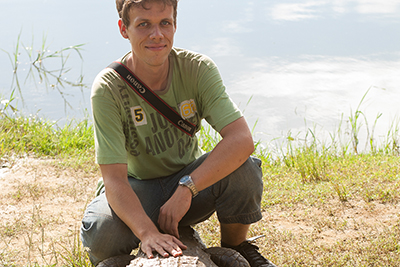The high North of Ghana
Paga - Living with the Crocodiles
The small town of Paga with its approximately 10,000 inhabitants is located in the far north of Ghana and despite its rather small size has brought it to a high degree of notoriety. This is partly due to the fact that on the Ghanaian side it forms the border town with Burkina Faso on the main route to Ouagadougou and on the other hand it hosts the great touristic attraction of the place: the Paga Crocodile Pond.
It is possible to get totally close to the crocodiles living here and even take a seat on them for a few photos. In fact, I haven't heard of it going wrong at some point but it's a rather strange feeling to surrender to such an animal. For the inhabitants of Paga, however, the question of a possible danger does not arise at all because the crocodiles are considered sacred here and are an important symbol for the entire city and would therefore never hurt the people as it is said here. The founding myth of Paga also goes back to this majestic animal. Around the year 1400 a man named Naveh was rescued from death by a crocodile during a hunting trip at this area. In great gratitude he then left his home village and founded the place on the site of his rescue called Ayipaga (translated as 'My eye rests on this place'), or Paga for short. No matter how much credibility you deplore this history, the symbolic importance of the animal is omnipresent in Paga and the touristic value today also has a positive economic aspect for the city.
The Crocodile Pond itself is accordingly also touristically developed and has a kind of covered jetty, which in my opinion, however, clearly takes away the place from its original charm. On my second visit here, however, I was lucky that the crocodiles were not directly at the main pond, but a little further away at a small pond close to the houses of the village. Here the whole scenery seemed much more authentic. Even if it is certainly something special to be able to sit on a living crocodile, I personally was impressed by the slightly lesser-known Spot Pagas, which I would like to present below.
Pikworo Slave Camp
If you just walk through the beautiful landscape about 3 km east of Paga you would hardly get the idea of being at a historically important point with a dark background. You might wonder what the signs "Punishment Rock" and "Watch Tower" mean because rather it does not indicate the relevance of the place. The explanation: here is the Pikworo Slave Camp located which served as a stopover for people held captive during the period of the slave trade on the way to the trading town of Salaga (120 km southeast of Tamale). From there they usually went on to the coast to one of the numerous castles that served for slave trade and ultimately without any hope of returning brought to the ships towards America. This, of course, only applied to the slaves who survived the circumstances of the journey because the long way was of course to be covered on foot and the supply was poor, which already cost the lives of many people.
Already here in the far north near Paga the conditions must have been dramatic, even if the dark dungeons of the castles radiate even more horror than the more inviting landscape here around the Pikworo Slave Camp. It is precisely this landscape that is shaped by numerous rocks, which were used to keep the slaves here. I mentioned the "Watch Tower" before. These were, for example, high rock formations which were perfectly suitable for the slave traders to overlook the landscape and find fugitive slaves. An escape was correspondingly very difficult and the punishments hard. The also mentioned "Punishment Rock" for example lay in the middle of the sun and here punished people were tied all day which must have been imaginably cruel in the climate here in the north. Another punishment was to create the "plates" for other slaves which were corresponding scrapes in the rocks, just deep enough to be able to eat from them like of a bowl.
Fortunately, today this is a peaceful place but it is perfectly suited to remember to what people are always able to do to each other.
Sirigu - Northern Land Life
The village of Sirigu is more exemplary for numerous villages of this kind as you find them in the far north of Ghana but also cross-border, for example in Burkina Faso. However, it has achieved national fame as the SWOPA Center has been set up here where traditional craftsmanship is exhibited and offered for sale. As a rule, the objects were made by women of the region and are primarily pottery or braided baskets. In addition to this cultural centre, you can also take advantage of the opportunity to look at the courtyards with the partly colorfully painted houses and thus get a certain insight into life here in the north of Ghana.
A very special encounter took place during our excursion, when we unpacked the drone in an open field to take a few pictures of a solitary baobab tree. Pretty quickly we had a large group of people around us who looked with a certain shyness but above all very great curiosity at this strange device and after understanding the way it works very much interest in the recordings and the technical showed possibilities. If drones have already become the norm in Ghanaian cities and attract hardly any attention, here in the country such a thing is certainly still the highlight of the week for many.


-kl.jpg)
-kl.jpg)
-kl.jpg)
-kl.jpg)
-kl.jpg)

-kl.jpg)
-kl.jpg)
-kl.jpg)
-kl.jpg)
-kl.jpg)
-kl.jpg)
-kl.jpg)
-kl.jpg)
-kl.jpg)
-kl.jpg)
-kl.jpg)
-kl.jpg)
-kl.jpg)
-kl.jpg)
-kl.jpg)
-kl.jpg)
-kl.jpg)